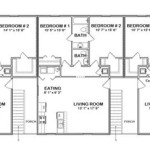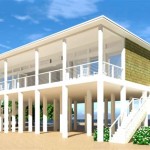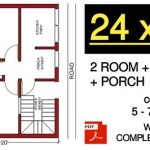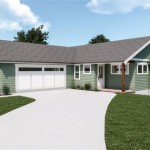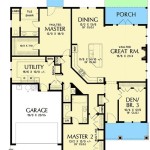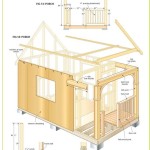The Allure and Functionality of the Two-Bedroom, One-Bath Open Floor Plan
The two-bedroom, one-bath open floor plan has become a prevalent design choice in contemporary housing. This configuration aims to maximize usable space and create a more fluid and interconnected living environment. Its popularity stems from its adaptability to various lifestyles, ranging from single individuals and young couples to small families and roommates. Understanding the benefits, challenges, and design considerations associated with this type of floor plan is crucial for potential homeowners, renters, and real estate investors alike.
An open floor plan, at its core, minimizes the presence of interior walls, particularly between the living room, dining area, and kitchen. This creates a larger, more unified space that promotes a sense of spaciousness, even within a relatively compact footprint. The strategic removal of barriers allows for natural light to permeate the entire area, contributing to a brighter and more inviting atmosphere. This contrasts sharply with more traditional layouts that often compartmentalize living spaces, resulting in smaller, more isolated rooms.
The two-bedroom, one-bath open floor plan is frequently found in apartments, condominiums, and smaller single-family homes. Its appeal largely lies in its ability to offer a comfortable living experience without requiring a significant amount of square footage. By efficiently utilizing the available space, this design aims to provide a practical and aesthetically pleasing living solution for a diverse range of occupants.
Enhanced Social Interaction and Family Connectivity
One of the primary advantages of a two-bedroom, one-bath open floor plan is its facilitation of social interaction and family connectivity. The absence of dividing walls between the primary living areas fosters a sense of togetherness. Individuals preparing meals in the kitchen remain connected to those relaxing in the living room or dining area. This seamless integration is especially beneficial for families with young children, as parents can supervise their activities while engaged in other tasks. Similarly, for those who enjoy entertaining guests, an open floor plan allows for easy flow of conversation and movement, creating a more inclusive and engaging social environment.
The visibility afforded by the open layout allows for easier communication and monitoring. Sounds and conversations carry more freely, which can be both a benefit and a drawback, depending on the household dynamics. The constant connection can, however, foster a stronger sense of community within the living space. Shared experiences are amplified when activities occur in a single, unified environment, promoting a feeling of belonging and shared activity.
Furthermore, the open floor plan promotes a more relaxed and informal atmosphere. The lack of defined boundaries encourages a more casual and fluid lifestyle. This can be particularly appealing for individuals who prefer a less structured and more adaptable living environment. The ability to easily reconfigure furniture and adjust the use of the space allows for greater flexibility in responding to changing needs and preferences.
Space Optimization and Versatility
The inherent design of a two-bedroom, one-bath open floor plan prioritizes space optimization. By eliminating unnecessary walls, the design maximizes the utilization of every square foot. This is particularly important in smaller living spaces, where every inch counts. The open flow allows for furniture to serve multiple purposes and for spaces to be easily adapted to different functions.
For example, a dining area can be quickly transformed into a workspace, or a living room can be reconfigured to accommodate a larger gathering. The flexibility inherent in the open floor plan makes it well-suited for individuals who require a versatile living environment that can adapt to their evolving needs. This is especially attractive to those who work from home or frequently entertain guests.
Strategic furniture placement plays a crucial role in defining distinct zones within the open space. Area rugs, strategically placed sofas, and carefully positioned lighting fixtures can help delineate the living room, dining area, and kitchen, without resorting to the use of physical barriers. This allows for creating a sense of order and visual separation within the overall open layout. The use of multifunctional furniture, such as storage ottomans or sofa beds, further enhances the space-saving potential of the open floor plan.
Moreover, the open floor plan often incorporates features that maximize natural light penetration. Large windows and strategically placed skylights can flood the entire space with daylight, creating a brighter and more inviting atmosphere. The absence of interior walls allows the light to travel freely throughout the area, reducing the need for artificial lighting and contributing to a more energy-efficient living environment. This natural light also enhances the perception of spaciousness, making the living space feel larger and more airy.
Challenges and Design Considerations
While the two-bedroom, one-bath open floor plan offers numerous advantages, it also presents certain challenges that require careful consideration during the design and implementation phases. One of the most significant challenges is managing noise levels. The absence of walls allows sound to travel freely throughout the entire space, which can be disruptive, particularly in households with multiple occupants or during activities that require concentration.
Effective soundproofing measures, such as the use of thick carpets, sound-absorbing wall panels, and strategically placed furniture, can help mitigate noise transmission. In addition, thoughtful zoning strategies can help minimize the impact of noise on different areas of the living space. For example, placing the bedrooms away from the main living area can help ensure a more peaceful and restful sleeping environment.
Another challenge associated with open floor plans is maintaining a sense of privacy. The lack of physical barriers can make it difficult to create private spaces for relaxation, work, or personal activities. Strategic use of furniture, screens, or curtains can help create temporary partitions and define more private zones within the open layout. Moreover, carefully considering the placement of furniture and the orientation of the space can help create a sense of enclosure and privacy without sacrificing the openness of the design.
Maintaining cleanliness and organization is also crucial in an open floor plan. Because everything is visible, clutter and disarray can quickly become overwhelming and detract from the overall aesthetic appeal of the space. Regular cleaning and organization are essential for maintaining a comfortable and inviting living environment. Incorporating ample storage solutions, such as built-in cabinets, shelving units, and storage ottomans, can help keep clutter at bay and ensure that everything has its designated place.
Furthermore, temperature control can be a challenge in open floor plans. Heating and cooling systems may struggle to evenly distribute air throughout the entire space, leading to temperature imbalances and discomfort. The use of ceiling fans, strategically placed vents, and energy-efficient windows can help improve airflow and maintain a more consistent temperature throughout the living space. Programmable thermostats can also help regulate temperature and optimize energy consumption.
Finally, design cohesion is essential for creating a harmonious and aesthetically pleasing open floor plan. The furniture, décor, and color palettes should be carefully selected to create a unified and consistent look throughout the entire space. Consider establishing a clear design theme and sticking to it throughout the entire process. Using a consistent color palette, incorporating similar textures and patterns, and carefully selecting furniture that complements the overall design can help create a cohesive and visually appealing living environment.
Ultimately, the success of a two-bedroom, one-bath open floor plan depends on careful planning, thoughtful design, and a clear understanding of the individual needs and preferences of the occupants. By addressing the challenges and maximizing the benefits, it is possible to create a functional, comfortable, and aesthetically pleasing living space that enhances the quality of life.

Country Plan 1 224 Square Feet 2 Bedrooms Bathroom Floor 7568 00013 America S Best House Plans

2 Bedroom House Plans Open Floor Plan

Simple 2 Bedroom 1 Bath Cabin 1200 Sq Ft Open Floor Plan With Covered Front Porch

Adu Floor Plans 700 Sq Ft Long 2 Bedroom 1 Bath Design

2 Bedroom House Plans Monster

2 Bedroom House Plans With Garage And Open Floor Plan

2 Bedroom Rustic Lake Style House Plan 2045 Silverton

22x32 House 2 Bedroom 1 Bath 704 Sq Ft Floor Plan Instant Model 1b

Open Concept Two Bedroom Small House Plan Other Examples At This Link Floor Plans Cottage

Modern Plan 812 Square Feet 2 Bedrooms 1 Bathroom Floor 1462 00175 America S Best House Plans

